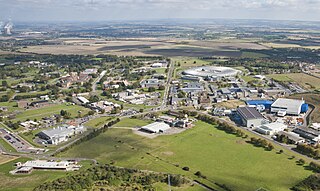Grid computing is the use of widely distributed computer resources to reach a common goal. A computing grid can be thought of as a distributed system with non-interactive workloads that involve many files. Grid computing is distinguished from conventional high-performance computing systems such as cluster computing in that grid computers have each node set to perform a different task/application. Grid computers also tend to be more heterogeneous and geographically dispersed than cluster computers. Although a single grid can be dedicated to a particular application, commonly a grid is used for a variety of purposes. Grids are often constructed with general-purpose grid middleware software libraries. Grid sizes can be quite large.
E-Science or eScience is computationally intensive science that is carried out in highly distributed network environments, or science that uses immense data sets that require grid computing; the term sometimes includes technologies that enable distributed collaboration, such as the Access Grid. The term was created by John Taylor, the Director General of the United Kingdom's Office of Science and Technology in 1999 and was used to describe a large funding initiative starting in November 2000. E-science has been more broadly interpreted since then, as "the application of computer technology to the undertaking of modern scientific investigation, including the preparation, experimentation, data collection, results dissemination, and long-term storage and accessibility of all materials generated through the scientific process. These may include data modeling and analysis, electronic/digitized laboratory notebooks, raw and fitted data sets, manuscript production and draft versions, pre-prints, and print and/or electronic publications." In 2014, IEEE eScience Conference Series condensed the definition to "eScience promotes innovation in collaborative, computationally- or data-intensive research across all disciplines, throughout the research lifecycle" in one of the working definitions used by the organizers. E-science encompasses "what is often referred to as big data [which] has revolutionized science... [such as] the Large Hadron Collider (LHC) at CERN... [that] generates around 780 terabytes per year... highly data intensive modern fields of science...that generate large amounts of E-science data include: computational biology, bioinformatics, genomics" and the human digital footprint for the social sciences.

The Rutherford Appleton Laboratory (RAL) is one of the national scientific research laboratories in the UK operated by the Science and Technology Facilities Council (STFC). It began as the Rutherford High Energy Laboratory, merged with the Atlas Computer Laboratory in 1975 to create the Rutherford Lab; then in 1979 with the Appleton Laboratory to form the current laboratory.
United States federal research funders use the term cyberinfrastructure to describe research environments that support advanced data acquisition, data storage, data management, data integration, data mining, data visualization and other computing and information processing services distributed over the Internet beyond the scope of a single institution. In scientific usage, cyberinfrastructure is a technological and sociological solution to the problem of efficiently connecting laboratories, data, computers, and people with the goal of enabling derivation of novel scientific theories and knowledge.

TeraGrid was an e-Science grid computing infrastructure combining resources at eleven partner sites. The project started in 2001 and operated from 2004 through 2011.

NorduGrid is a collaboration aiming at development, maintenance and support of the free Grid middleware, known as the Advanced Resource Connector (ARC).
Sun Cloud was an on-demand Cloud computing service operated by Sun Microsystems prior to its acquisition by Oracle Corporation. The Sun Cloud Compute Utility provided access to a substantial computing resource over the Internet for US$1 per CPU-hour. It was launched as Sun Grid in March 2006. It was based on and supported open source technologies such as Solaris 10, Sun Grid Engine, and the Java platform.

European Grid Infrastructure (EGI) is a series of efforts to provide access to high-throughput computing resources across Europe using grid computing techniques. The EGI links centres in different European countries to support international research in many scientific disciplines. Following a series of research projects such as DataGrid and Enabling Grids for E-sciencE, the EGI Foundation was formed in 2010 to sustain the services of EGI.
The D-Grid Initiative was a government project to fund computer infrastructure for education and research (e-Science) in Germany. It uses the term grid computing. D-Grid started September 1, 2005 with six community projects and an integration project (DGI) as well as several partner projects.
The Science and Technology Facilities Council (STFC) is a United Kingdom government agency that carries out research in science and engineering, and funds UK research in areas including particle physics, nuclear physics, space science and astronomy.
Research Computing Services, provides the focus for the University of Manchester's activities in supercomputing or high-performance computing, grid computing or e-science and computational science. Research Computing Services activities include services, training and research & development.
The Nordic Data Grid Facility, or NDGF, is a common e-Science infrastructure provided by the Nordic countries for scientific computing and data storage. It is the first and so far only internationally distributed WLCG Tier1 center, providing computing and storage services to experiments at CERN.
The INFN Grid project was an initiative of the Istituto Nazionale di Fisica Nucleare (INFN) —Italy's National Institute for Nuclear Physics—for grid computing. It was intended to develop and deploy grid middleware services to allow INFN's users to transparently and securely share the computing and storage resources together with applications and technical facilities for scientific collaborations.

gLite is a middleware computer software project for grid computing used by the CERN LHC experiments and other scientific domains. It was implemented by collaborative efforts of more than 80 people in 12 different academic and industrial research centers in Europe. gLite provides a framework for building applications tapping into distributed computing and storage resources across the Internet. The gLite services were adopted by more than 250 computing centres, and used by more than 15000 researchers in Europe and around the world.

The P-GRADE Grid Portal was software for web portals to manage the life-cycle of executing a parallel application in grid computing. It was developed by the MTA SZTAKI Laboratory of Parallel and Distributed Systems (LPDS) at the Hungarian Academy of Sciences, Hungary, from around 2005 through 2010.

The Laboratory of Parallel and Distributed Systems (LPDS), as a department of MTA SZTAKI, is a research laboratory in distributed grid and cloud technologies. LPDS is a founding member of the Hungarian Grid Competence Centre, the Hungarian National Grid Initiative, and the Hungarian OpenNebula Community, and also coordinates several European grid/cloud projects.
The SHIWA project within grid computing was a project led by the LPDS of MTA Computer and Automation Research Institute. The project coordinator was Prof. Dr. Peter Kacsuk. It started on 1 July 2010 and lasted two years. SHIWA was supported by a grant from the European Commission's FP7 INFRASTRUCTURES-2010-2 call under grant agreement n°261585.
GridPP is a collaboration of particle physicists and computer scientists from the United Kingdom and CERN. They manage and maintain a distributed computing grid across the UK with the primary aim of providing resources to particle physicists working on the Large Hadron Collider (LHC) experiments at CERN. They are funded by the UK's Science and Technology Facilities Council. The collaboration oversees a major computing facility called the Tier1 at the Rutherford Appleton Laboratory (RAL) along with the four Tier 2 organisations of ScotGrid, NorthGrid, SouthGrid and LondonGrid. The Tier 2s are geographically distributed and are composed of computing clusters at multiple institutes.
Science gateways provide access to advanced resources for science and engineering researchers, educators, and students. Through streamlined, online, user-friendly interfaces, gateways combine a variety of cyberinfrastructure (CI) components in support of a community-specific set of tools, applications, and data collections.: In general, these specialized, shared resources are integrated as a Web portal, mobile app, or a suite of applications. Through science gateways, broad communities of researchers can access diverse resources which can save both time and money for themselves and their institutions. As listed below, functions and resources offered by science gateways include shared equipment and instruments, computational services, advanced software applications, collaboration capabilities, data repositories, and networks.







